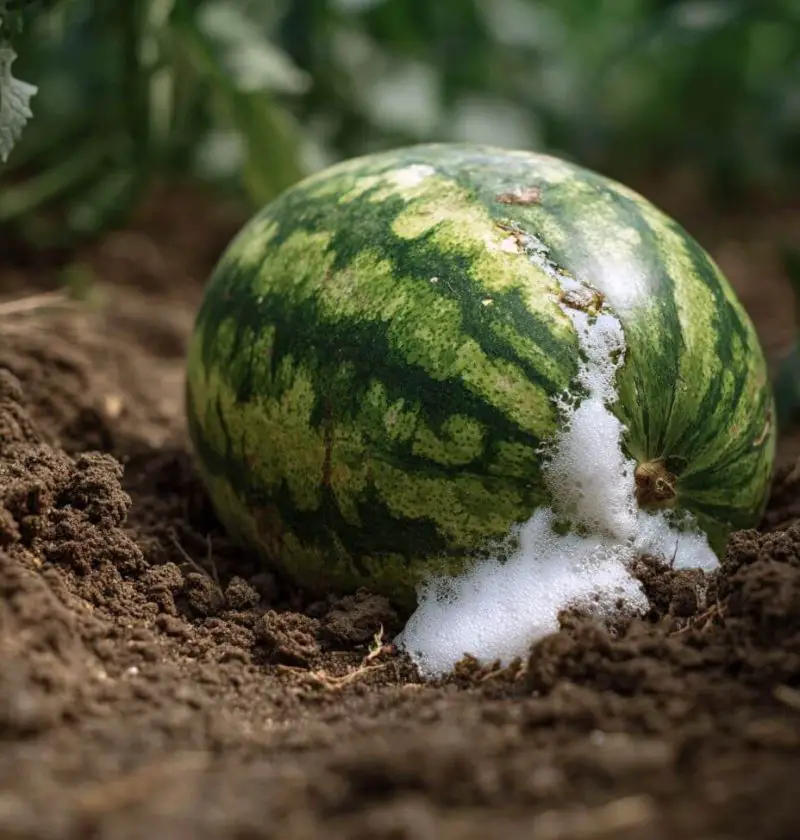Save This Recipe
We all love a big, juicy watermelon on a hot summer day. It’s crisp, sweet, and just downright refreshing. But let me ask you something—have you ever cut into a watermelon and noticed it… foaming?
Yep. Foaming.
Not fizzing like soda. Not a little juicy drip. We’re talking actual bubbles, sometimes spilling out like your watermelon just took a bubble bath.
If you’ve seen it, you know how odd (and a little creepy) it feels. And if you haven’t? Well, let’s hope you never do—but just in case, here’s what you need to know to stay safe and smart.
First of All: Don’t Eat It!
Let me be clear right out of the gate: if your watermelon is foaming, do NOT eat it. I don’t care how good it smells or if you think you can just “cut around the weird part.” Nope. Trust me, friend—toss it.
Why? Because a foaming watermelon is a sign that something’s gone wrong inside. And it’s not just “a little too ripe.” It could mean fermentation, bacteria, or even chemicals messing around where they shouldn’t be.
So… What Makes a Watermelon Foam, Anyway?
Great question! It usually comes down to one thing: fermentation.
Here’s how it happens:
-
Overripe fruit starts breaking down, and the sugars go wild.
-
Yeast or bacteria sneak in (through cracks, bruises, or holes) and start eating those sugars.
-
As they eat, they produce gas. That gas builds up pressure, and suddenly—foam.
Kind of like homemade bread dough bubbling up… except this is your watermelon. Not quite as charming, huh?
A few other things that might be at play:
-
Microbial contamination: Bacteria can enter through damaged spots in the rind.
-
Heat: Leaving the fruit in a hot car or warm kitchen? Perfect playground for microbes.
-
Chemical residue: Rare, but some foaming can happen if weird reactions occur from leftover pesticides or surface treatments.
Bottom line: foam means fermentation or chemical reaction. Neither one belongs in your fruit salad.
Is It Dangerous?
Yes, ma’am—it can be. Here’s why:
-
Food poisoning: If bacteria are behind the foam, you could end up with a nasty case of stomach cramps, nausea, or worse.
-
Chemical exposure: If pesticides or treatments are the culprit, you’re looking at potential chemical poisoning.
-
Pressure build-up: Believe it or not, a foaming watermelon can actually explode if left too long. Not common, but it’s happened. (Just imagine that mess in your kitchen. Nope.)
Okay, My Watermelon’s Foaming. What Do I Do?
Good news—you’re not the first person to find yourself in this sticky situation. Just follow these steps and you’ll be fine:
-
Back away from the fruit bowl – No tasting, no sniffing, no poking around to “see if it’s still good.” Just don’t.
-
Get it out of your kitchen – Wrap it up (double-bag it if you need to) and move it outside. Trash bin’s fine—just make sure critters or kiddos can’t get into it.
-
Disinfect everything it touched – Knife, cutting board, counter, sink… give it all a good clean with hot, soapy water. Follow up with disinfectant.
-
Wash those hands – Scrub like you just prepped raw chicken. You want every trace of that weird foam off your skin.
-
Watch for symptoms – If anyone accidentally ate any of the fruit, keep an eye out for signs of foodborne illness. If they feel sick, call your doctor.
-
Report it if needed – If something seems seriously off (like you bought it from a major store and saw others complaining), let your local health department know. They’ll look into it and might prevent someone else from getting sick.
How to Keep Your Watermelon from Going Weird in the First Place
The good news? This foaming stuff is pretty rare. But just like you wouldn’t leave milk out in the sun, you can take steps to keep your watermelon happy and safe.
-
Check it before you buy: Look for cracks, bruises, soft spots, or anything sticky. If it feels “too perfect” or suspiciously shiny, walk away.
-
Store it cool and dry: Keep whole melons at room temp in a cool place—but not out baking in the sun. Once it’s cut, straight into the fridge in a sealed container.
-
Wash before you slice: Even if you’re not eating the rind, wash it well. Dirt, bacteria, and chemicals on the outside can get dragged inside with your knife.
-
Eat it within a few days: Cut watermelon doesn’t last long. Enjoy it fresh and don’t try to stretch it a week—this isn’t the time for leftovers.
Final Takeaway: When in Doubt, Throw It Out
I know. Wasting food stinks. But your health—and your family’s health—is more important than a few slices of sketchy fruit. If something seems off, trust your instincts.
Watermelon is supposed to be joyful, not jarring. So keep an eye out, stay smart, and go grab yourself a fresh, normal melon next time. You deserve the good stuff.

